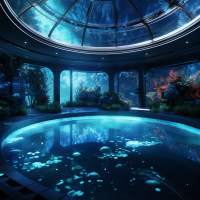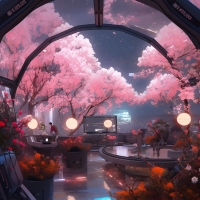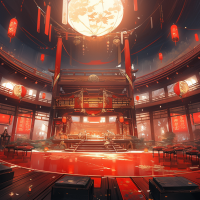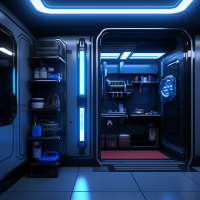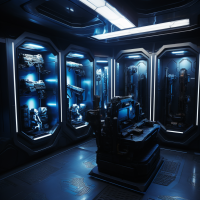Table of Contents
Tengumo-Class Space Station
The Tengumo-Class Space Station is a mobile space station developed by the Yugumo Corporation in late YE 45 with the first station set to come online in late YE 45 with others following in YE 46.
Tengumo 天雲 is a Yamataigo (邪馬台語) word meaning “Imperial/Celestial Cloud”.
History and Background
Until YE 45 the Yugumo Corporation had not developed their own class of mobile space station or shipyard. They had relied on the Geshrinari Shipyards Ge-H1-7A - Kōdaina Minato-Class Orbital Installation of which Port Jiyuu and its modified, older industrial station Port Siren(Kodoku-Class Mining and Processing Facility). Both stations were modified for mobile use and taken with the Colonization Initiative Alliance fleet to the Kosuke Sector1)2)3). Unwilling to commit to the daunting task or price tag of having two Ge-H1-7A - Kōdaina Minato-Class Orbital Installation constructed to replace them, the Yugumo Corporation decided to finally construct their own class of mobile space station that was customized to their needs at a more reasonable cost and size.
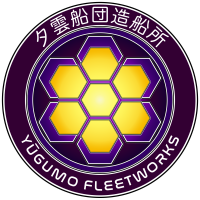 Yugumo Fleetworks brought together their design team and came up with the concept for the new Tengumo-Class Space Station. The primary design schematics were approved in YE 45.7, with the first of the planned stations set to come online sometime in the early part of YE 46. A second version of the station was planned to replace the Kodoku-Class Mining and Processing Facility, but it was set as a lower priority as that the purchased Dragon-class Mobile Refinery vessels could handle refinery needs for the corporation until the design could be perfected.
Yugumo Fleetworks brought together their design team and came up with the concept for the new Tengumo-Class Space Station. The primary design schematics were approved in YE 45.7, with the first of the planned stations set to come online sometime in the early part of YE 46. A second version of the station was planned to replace the Kodoku-Class Mining and Processing Facility, but it was set as a lower priority as that the purchased Dragon-class Mobile Refinery vessels could handle refinery needs for the corporation until the design could be perfected.
In reality, parts of the design for the Tengumo-Class began long before the initialization of the project, as the production of their own dedicated shipyards and space stations had been circulating since the Yugumo Fleetworks had come together in YE 43, it was just there had not been a call for their development from management until this project started. The design team came forward with multiple suggestions that were updated plans from what had been a wishlist created for the day the company was in need.
Kumo no Kagayaki Station will be the first of these stations to be built. It will be positioned in the Jiyuu System. In YE 46, Motoyoshi Arisu ordered three additional stations to be built.4)
Description and Design Goals
The Tengumo-Class Space Station is a mobile space station designed to serve as a civilian commercial hub, residential “city in space” and port-of-call in key systems within the Yamatai Star Empire, in particular, but not limited to the Motoyoshi Colonial Sector and future development in the Kosuke Sector5). The decision for the mobile design was influenced by not only the company's need to be able to move the stations between locations but also to utilize them as part of the overall evacuation plans for the systems they would be built in.
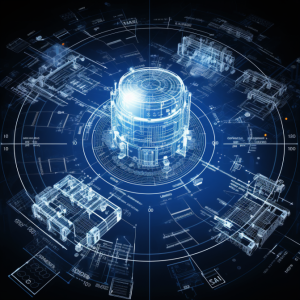
Design Goals and Mission Specialization
The Tengumo-Class Space Station was designed to meet the following design specifications set by the management of the Yugumo Corporation:
- To serve as a commercial hub for imports and exports in a system.
- To accommodate civilian populations serving as a city in space.
- To have functional shipyards for the production of Yugumo Fleetworks or the customer.
- With the start of the Third Mishhuvurthyar War, serve as part of the evacuation structure for systems in the event of invasion. 6)
Statistics and Performance
Statistical and performance information for the Tengumo-Class Space Station.
| General Statistics for the Tengumo-Class Space Station | |
|---|---|
| Year Introduced | 1A YE 45 |
| Class/Nomenclature | YU-H1-1A |
| Alternative Nomenclature | None. |
| Designers | Yugumo Fleetworks |
| Manufacturer | Yugumo Fleetworks, Yugumo Corporation |
| Fielded By | Yugumo Corporation |
| Range | Unlimited Range |
| Maintenance Cycle | Five years with refits as needed. |
| Lifespan | This space station is designed for fifty years of continual use. |
| Pricing | 850,000,000 KS |
Passengers and Crew
The personnel on board the space station. Actual occupancy can vary due to personnel shortages or other situations.
| Standard Occupancy 1A | |
|---|---|
| QTY | TYPE |
| 15.2 Million | Personnel |
| 400 | Skeleton Crew7) |
| Emergency | |
| 20 Million | |
Vessel Dimensions
- Diameter (Length and Width): 27.00km
- Height: 17.25km
- Decks: 3450 8)
Propulsion and Performance
This vessel complies with the Starship Speed Standard.
| Class | Hoshi III Series Multi-stage Turbo Plasma Drives | Mizu II Series CDD - Tsunami II | Yumeoibito Hyperspace Fold Drive -Super |
|---|---|---|---|
| Tengumo-Class | .20c | 7,500c | 195,192 c (0.20 ly/m) |
The Tengumo-Class Space Station is not designed for atmospheric or water use. It is not capable of making planetary landings.
Damage Capacity and Combat Durability
This vessel's damage capacity statistics are in compliance with Damage Rating (Version 3).
Damage Rating (Version 3) is Tier 15, Space Station.
Appearance
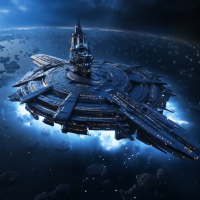 The Tengumo-Class Space Station is comprised of a series of stacked saucers of decreasing size towards the dorsal side of the station. The upper-most saucer has a series of spoke-like extensions which include the concourses and primary docking stations for vessels that visit the station. Two very large production bays extend out from the entire structure of the station which are the station's primary shipbuilding facilities. A large superstructure tower is set upon the upper-most saucer which houses the station's command sector. The ventral side of the station mirrors the dorsal side, minus the superstructure tower(not visible in the art).
The Tengumo-Class Space Station is comprised of a series of stacked saucers of decreasing size towards the dorsal side of the station. The upper-most saucer has a series of spoke-like extensions which include the concourses and primary docking stations for vessels that visit the station. Two very large production bays extend out from the entire structure of the station which are the station's primary shipbuilding facilities. A large superstructure tower is set upon the upper-most saucer which houses the station's command sector. The ventral side of the station mirrors the dorsal side, minus the superstructure tower(not visible in the art).
The station follows the Design Ethos of Yugumo Fleetworks and although a customer can request custom color schemes, by default, the station comes in the standard Yūzuki9) livery.
Inside The Space Station
The extensive interiors of the station are listed below.
Getting Around Inside The Station
 The Tengumo-Class Station is equipped with Yugumo Standard Interior Transportation Systems, introduced in YE 45 by Yugumo Fleetworks, which are a set of standardized transit systems designed for their ships and space stations. These systems include passageways, lifts, and light rail transit.
The Tengumo-Class Station is equipped with Yugumo Standard Interior Transportation Systems, introduced in YE 45 by Yugumo Fleetworks, which are a set of standardized transit systems designed for their ships and space stations. These systems include passageways, lifts, and light rail transit.
- Passageways are essential corridors connecting various ship compartments and areas. They are well-lit, efficiently designed, and feature signage for directions and safety. They provide stability through handrails in case of gravity fluctuations or combat situations.
- Lifts are multi-directional elevators that efficiently move passengers and cargo within starships. They are operated through ship systems, equipped with security measures, and have safety protocols in place. The interior is designed for passenger comfort, and there are also cargo lifts for heavier items.
- Light Rail Transit is a cutting-edge transportation system primarily found in space stations. It uses graviton-based propulsion, allowing passengers to travel in specialized transit pods with adjustable gravity fields. The system is integrated into the station's infrastructure, prioritizing safety and redundancy with automated collision avoidance and emergency procedures.
Command Deck
Located in the Command Superstructure.
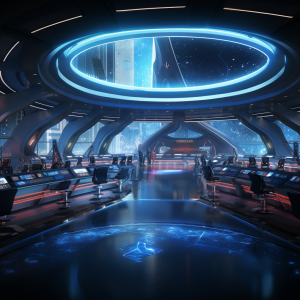 Rather than using the standard layouts on Yugumo Fleetworks vessels, the new Yugumo Standard Bridge uses station/console modules that can be arranged into any layout the client wishes. It serves as the central command hub, customized for each ship's needs. Common features include the default color palette, advanced lighting, and efficient interfaces. Key components include the central command console, Shipmaster's chair, helm and navigation stations, tactical and technical stations, a science station, and a communication center. This bridge efficiently facilitates communication, navigation, and control, ensuring effective station operations.10)
Rather than using the standard layouts on Yugumo Fleetworks vessels, the new Yugumo Standard Bridge uses station/console modules that can be arranged into any layout the client wishes. It serves as the central command hub, customized for each ship's needs. Common features include the default color palette, advanced lighting, and efficient interfaces. Key components include the central command console, Shipmaster's chair, helm and navigation stations, tactical and technical stations, a science station, and a communication center. This bridge efficiently facilitates communication, navigation, and control, ensuring effective station operations.10)
Accomodations and Amenities
The Tengumo-Class Space Station represents the latest in space habitats and is designed to accommodate various activities, including living, visiting, and working in outer space. These standard accommodations and amenities generally apply to stations owned and operated by the Yugumo Corporation. They may not be present by request of clients purchasing the station custom-built for their needs.
| Accommodations | |
|---|---|
| Yugumo Standard Shipmaster's Cabin | Quarters for the Shipmaster |
| Yugumo Standard Licensed Crew Quarters | Quarters for the Licensed Crew |
| Yugumo Standard Rated Crew Bunkroom | Quarters for the Rated Crew |
| Amenities | |
| Yugumo Standard Adaptive Gravity Gym | A training/gym facility |
| Yugumo Standard Modular Crew Entertainment Lounge 11) | Modular entertainment rooms with many configurations |
| Yugumo Standard Galley | Crew Kitchen |
| Yugumo Standard Dining Hall | Crew Dining Hall |
| Yugumo Standard Wardroom | Officer's Dining Lounge |
| Yugumo Standard Rated Crew Showers and Bathhouse | Crew Showers and Bathhouse |
| Yugumo Standard Laundry Facility | Laundry Facilities |
| Yugumo NBY Banking Booth | Banking Services |
| Yugumo Standard Medical Bay | Hospital and Health Services |
Guests Accomodations
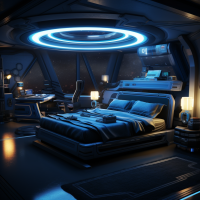 The station rents out the following:
The station rents out the following:
- Yugumo Standard Licensed Crew Quarters - 140KS/Night12)
- Yugumo Standard Rated Crew Bunkroom - 40KS/Night Per Bunk13)
Members of the Star Army of Yamatai and employees of the Yugumo Corporation are eligible for a 20% discount. Yugumo Corporation employees in transit or on duty can arrange rooms for free. Anyone in these special categories may also use the Yugumo Standard Dining Hall if they wish to save the expense of eating at the various restaurants onboard.
Depending on the Station and the owners, most Tengumo-Class Stations have their own hotels, hostels and other accommodations.14)
Unique Places on the Station Class
These are places unique to the Tengumo-Class Station. Actual Stations will have additional unique locations depending on the system they are built in and the preferences of their owners.15)
Some examples of unique interiors in the Tengumo-Class Space Station:
Service Areas
The service areas are accessible to the crew of the space station. They are scattered throughout the structure for easy access in key areas.
Damage Control Alcoves
The Damage Control Alcoves play a pivotal role in managing ship or facility damages. These alcoves, equipped with a KAIMON Damage Control Terminal, aid in locating and assessing damages, especially for those without a functional KAIMON/Ascendant Companion. They also house a variety of tools, equipment, and fabrication printers, enabling on-the-spot creation and provision of necessary repair materials.
Housekeeping Lockers
The Housekeeping Lockers house gear for the upkeep essentials for the station, promoting cleanliness and maintenance. Within these lockers, an array of innovative tools like Gravitational Brooms, Nanite-Infused Mops, and Sonic-Wave Disinfectors, along with various others, are stored for Support Staff use. Additionally, the locker facilitates automated cleaning through Utility Fog nanomachines and Guided Vacuum Drones, while also ensuring safety with its Hazardous Materials Containment and Recovery gear.
Armory
The Armories are specialized compartments within a starship dedicated to the storage, maintenance, and distribution of weapons and related equipment, crucial for defense and combat scenarios. Positioned strategically near the ship's bridge or critical areas, access to the armory is restricted to authorized personnel, with heavy fortification like reinforced bulkheads and Forcefield-Nested Isolation Doors ensuring security. Inside, a broad spectrum of weaponry, protective gear, and ammunition is housed, alongside maintenance stations for routine inspections and repairs.
Weapons Lockers
Additionally, smaller armory lockers placed around key areas provide quick access to emergency weaponry, embodying a well-thought-out design to bolster a vessel's readiness against potential threats and emergencies.
Launch Bays
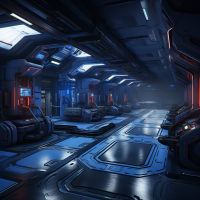 The Combined Launch Bays, inspired by the Multi-Purpose Launch Bays used on the Takumi-Class Expeditionary Command Cruiser, this Combined Launch Bay serves as a central hub for deploying and retrieving small craft, drones, and equipment, including power armor. Strategically located within the station, it features a spacious, well-lit enclosure with durable walls, floor markings for precise alignment during operations, and graviton systems for safe landings. Specialized storage racks and charging stations for power armor ensure accessibility and readiness, while maintenance workstations, crew access points, and robust safety systems guarantee operational efficiency and crew protection. Environmental controls and forcefields maintain a controlled atmosphere within the bay, facilitating seamless operations without the need for decompression.
The Combined Launch Bays, inspired by the Multi-Purpose Launch Bays used on the Takumi-Class Expeditionary Command Cruiser, this Combined Launch Bay serves as a central hub for deploying and retrieving small craft, drones, and equipment, including power armor. Strategically located within the station, it features a spacious, well-lit enclosure with durable walls, floor markings for precise alignment during operations, and graviton systems for safe landings. Specialized storage racks and charging stations for power armor ensure accessibility and readiness, while maintenance workstations, crew access points, and robust safety systems guarantee operational efficiency and crew protection. Environmental controls and forcefields maintain a controlled atmosphere within the bay, facilitating seamless operations without the need for decompression.
Factory
The Factory on the Space Station is the largest built by the company. Within these areas, skilled Engine Rating Crew and Engine Officers collaborate with advanced machinery like KAIMONand Yugumo Fabrication Systems to create a diverse range of items, from uniforms and drones to power armor. These facilities boast stringent quality control measures, robust security protocols, and precise environmental controls to ensure safety, precision, and efficiency throughout the manufacturing process. Materials are managed efficiently through nanofabrication systems, material recyclers, and resource processors, reducing reliance on external supplies and waste production. Located deep within the station's hull and connected to the Cargo Bays for efficient material movement.
Cargo Bays
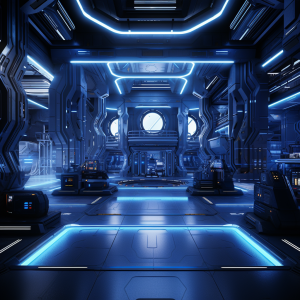 The Cargo Bays were inspired by the success of the Shuryoku-Class Super Freighter, this versatile cargo bay serves as the logistical hub of a starship or space station, facilitating the storage, transportation, and access to a diverse array of goods, equipment, and supplies crucial for missions, trade, exploration, and survival. Positioned typically in the central or lower section of the vessel for stability, the cargo bay comes in various sizes to accommodate the starship's type and purpose, with the capacity to store Standard Starship Cargo Containers efficiently using tracks, cranes, and robotic arms. Entry to the cargo bay is provided through large, Forcefield-Nested Isolation Doors, ensuring ship integrity during emergencies. Durandium Alloy-reinforced walls and modular securing mechanisms protect cargo during space travel, while Graviton Generated Forcefields maintain atmospheric and environmental conditions inside the container holds. Adjustable laser diode lighting enhances visibility, while environmental controls cater to cargo-specific needs. A range of cargo-handling equipment, including KAIMON/Ascendant Carrier, anti-gravity lifters, cargo cranes, and transport sleds, assists crew members in cargo handling, with software systems like KAIMON managing manifests and inventory for efficient tracking and retrieval.
The Cargo Bays were inspired by the success of the Shuryoku-Class Super Freighter, this versatile cargo bay serves as the logistical hub of a starship or space station, facilitating the storage, transportation, and access to a diverse array of goods, equipment, and supplies crucial for missions, trade, exploration, and survival. Positioned typically in the central or lower section of the vessel for stability, the cargo bay comes in various sizes to accommodate the starship's type and purpose, with the capacity to store Standard Starship Cargo Containers efficiently using tracks, cranes, and robotic arms. Entry to the cargo bay is provided through large, Forcefield-Nested Isolation Doors, ensuring ship integrity during emergencies. Durandium Alloy-reinforced walls and modular securing mechanisms protect cargo during space travel, while Graviton Generated Forcefields maintain atmospheric and environmental conditions inside the container holds. Adjustable laser diode lighting enhances visibility, while environmental controls cater to cargo-specific needs. A range of cargo-handling equipment, including KAIMON/Ascendant Carrier, anti-gravity lifters, cargo cranes, and transport sleds, assists crew members in cargo handling, with software systems like KAIMON managing manifests and inventory for efficient tracking and retrieval.
Production Bays
The two massive extensions of the Tengumo-Class Station's main structure are the station's production bays. They are large enough to support the construction space for up to eight Tanya-Class Expeditionary Heavy Cruiser each at a time. They are connected to the station's Factories to ensure the adequate movement of materials needed for ship construction to the bays. The bays include shipyard supervisor stations, KAIMON controlled robotic arms, cranes, and other machinery, and are well stocked with construction mecha.
Docking Structures
The station has six extendable docking arms designed to accommodate up to forty Misha-Class Explorer or Yūgure-class Merchant Destroyer along their sides. The larger docking connection at the end of the arms is designed for Tanya-Class Expeditionary Heavy Cruiser or larger vessels They were designed in expectation of the new Misha 2 which should be released sometime in YE 46.
External Construction Frames
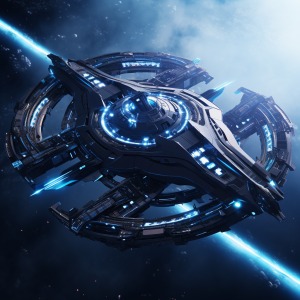 Due to the restrictions of internal construction bays, the station's production capabilities are increased by shipyard modules/external construction modules. These units have their own dedicated shipyard management offices, and Hoshi II Series Turbo Plasma Drives to assist them as they are positioned to construct starships externally from the station's main body. The units have extendable construction frames that can accommodate larger than standard vessels for construction or repair.
Due to the restrictions of internal construction bays, the station's production capabilities are increased by shipyard modules/external construction modules. These units have their own dedicated shipyard management offices, and Hoshi II Series Turbo Plasma Drives to assist them as they are positioned to construct starships externally from the station's main body. The units have extendable construction frames that can accommodate larger than standard vessels for construction or repair.
Sub-Systems
The systems and inner workings of the space station.
Hull and Spaceframe
The Tengumo utilizes a primarily Durandium Alloy hull structure. All windows and viewports utilize Transparent Durandium.
| Tengumo-Class Hull and Frame Assembly | |
|---|---|
| Primary SpaceFrame | Forcefield Reinforced Durandium Alloy Major Truss |
| Secondary SpaceFrame | Durandium Alloy Secondary Truss and Rod Assembly |
| Outer Plates | Sitearium coated Durandium Alloy Plate with Omnihue matrix |
| Lining | Yarvex Lining |
Propulsion Systems
The Tengumo-Class utilizes a modified Mizu II Series - Nami II CDD which maximizes the CDD performance at 7,500c. Distortion coils are located on the ventral side of the station.
In addition to the CDD, the Tengumo-class is equipped with Hoshi III Series Multi-stage Turbo Plasma Drives for sublight speed. Sublight performance for this craft usually can withstand 0.20c. Maneuvering Thrusters (ion thrusters) and the Plasma Projection System are used primarily for attitude adjustment and station keeping.
For the hyperspace fold, the station uses a Yumeoibito Hyperspace Fold Drive.
Power Systems
The Tengumo-class uses Kaminari Quantum Foam Generatorss for primary power, and fusion reactors for secondary power. The system is equipped with an integrated capacitor system to provide tertiary power. Tertiary Power can last 2-4 days (non-combat) or 8 hours (combat) in an emergency.
Integrated Electronics Systems
The Tengumo-class is equipped with the KAIMON-Prime Gate suite with its included communications and sensor systems. It also has the uplink and PANTHEON/SYNC connect module.
Shielding
The Tengumo-class's Mizu II Series - Tsunami II CDD is equipped with a (Civilian) Combined Field System, supplementary shields, and navigational shielding. The primary shields create a six-faced barrier.
Life Support and Emergency Systems
The Tengumo-Class Space Station is equipped with all the Yugumo Standard Life Support Systems as well as Yugumo Standard Fire-Fighting Equipment and Systems. They have Yugumo Standard Damage Control Alcoves scattered throughout the station and in key areas to ensure resources for damage control teams. In the event of a catastrophe, the station is equipped with "Ikigai" Type 43 Escape Pod.
Weapons
The Space Station's weapons systems are geared toward defense. The standard loadout is as follows:
- 40 x Super-"Yakaze" Series Anti-Starship Turrets - Tier 11
- 50 x Chōuryū Subsurface Torpedo/Sensor Platform - Tier 9 (Designed to be deployed Underwater - On Planet they are deployed near) OR Tier 9 Plasma Torpedo Platform (Space)
- 40 x "Suzukaze" Mini-Missile Launchers Type 43 - Tier 8
- 200 x "Tachikaze" Point Defense Cannons Type 43 - Tier 6
Small Craft and Armor Inventory
Each station carries a custom loadout of small craft and power armor.
OOC Notes
Expectations
Going along with Wes's suggestion17), it is expected that each station will have its own wiki article. It is expected that the person who makes those articles will include custom places such as; restaurants, hotels, unique compartments, and general modifications to the original design. This page serves as a foundation for what will be an exciting space station for your SARPiverse adventure.
| Products & Items Database | |
|---|---|
| Product Categories | space stations |
| Product Name | Tengumo-Class Space Station |
| Nomenclature | YU-H1-1A |
| Manufacturer | Yugumo Fleetworks |
| Year Released | YE 45 |
| Price (KS) | 850 ,000 ,000.00 KS |
| DR v3 max | Tier 15 |

